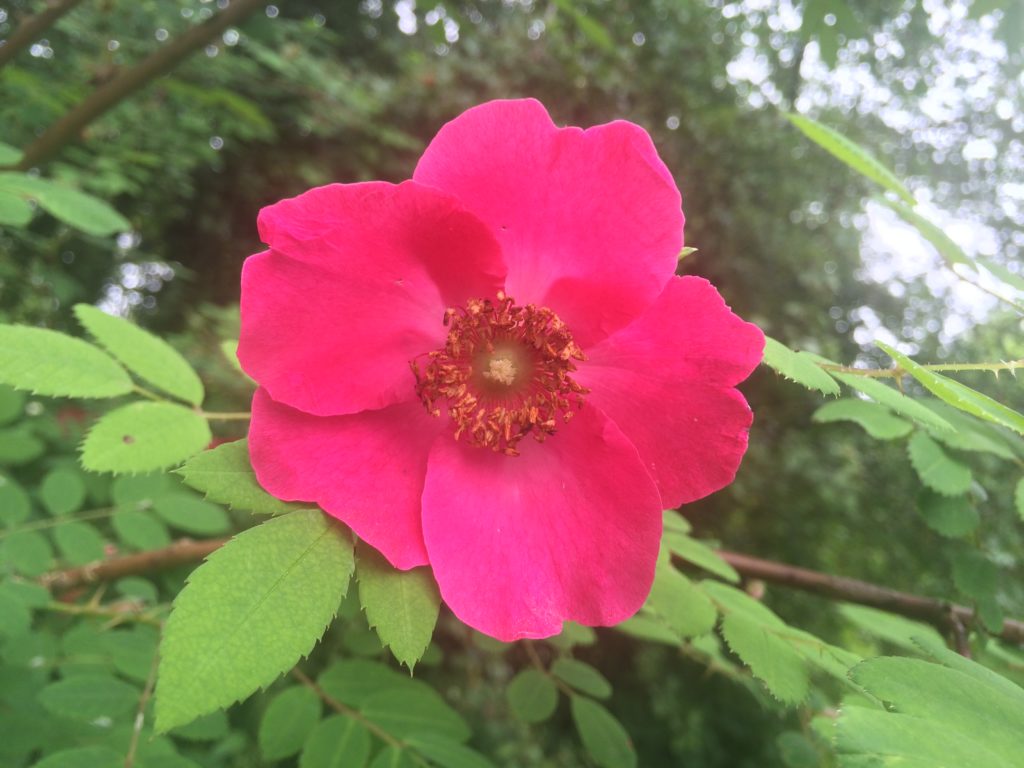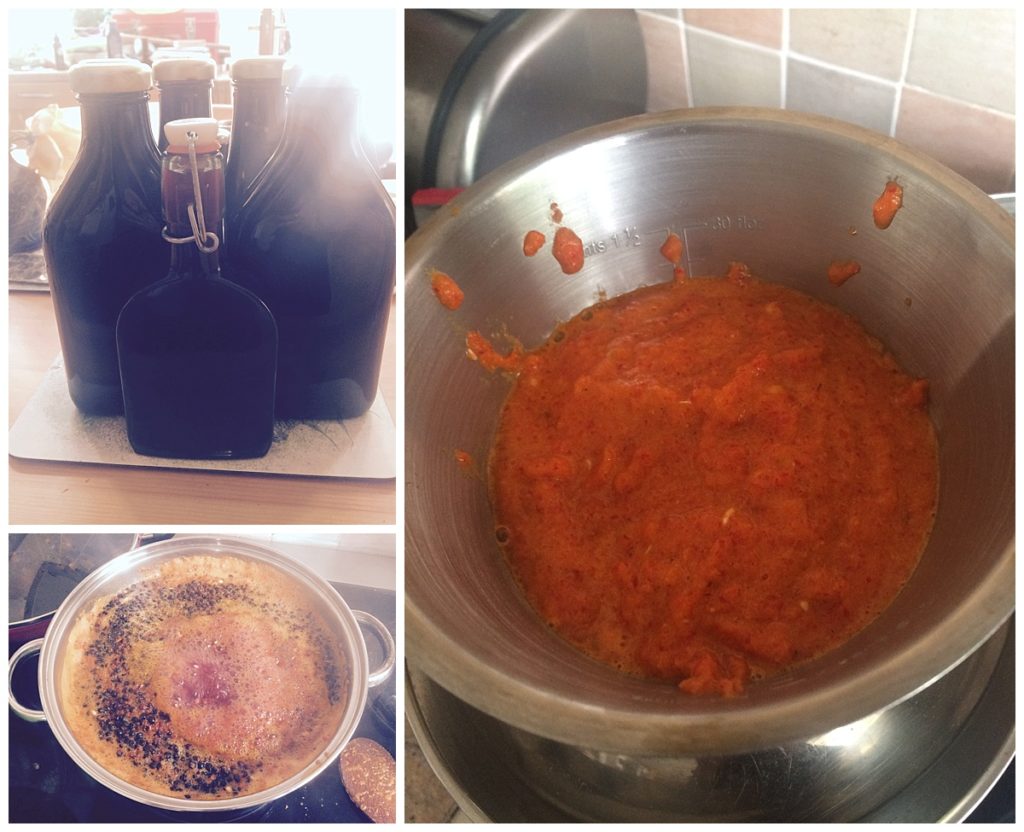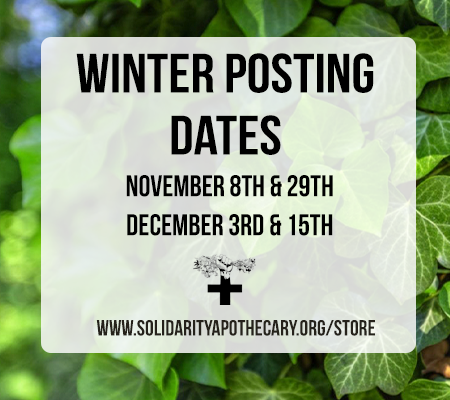Please note these plant profiles are a work in progress. I will always be adding to them as I keep learning about the amazing world of plant medicine.
Botanical Overview
Latin name: Rosa spp.
Plant family: Rosaceae
Identification: Roses have a climbing habit and prickly stems as in bramble but the stems are rounded in section, so they look smoother (apart from the prickles!). Their leaves are not evergreen, and are divided into 5-7 leaflets which, apart from the end one, are in two rows along the leaf stalk. Large stipules (leaf like structures) are attached to each side of the lower part of the leaf stalk. For wild roses, they have large white or pink flowers in the summer, becoming red ‘hips’ in the autumn (1).
Other species: There are 13 species of wild rose in Britain and many hundreds of different kinds of domestic cultivars. Wild roses include Field Rose (R. arvensis), Sweetbriar or Eglantine (R. rubiginosa), Downy rose (R. tomentosa). Commonly used medicinal roses include Apothecaries rose (R. gallica), Damask rose (R. damascena) and Provense rose (R. centifolia). Europe’s native rose is Dog Rose (R. canina).
Folk names in English: Rose, Queen of Flowers, Rosa, Shatapatri, Witch’s briar
Chemical constituents: Tannins, pectin, carotene, fruit acids, flavonoids, fatty oil, nicotinamide, vitamins A, B, C, E, K, + folic acid, calcium, potassium, sodium, sulphur, iron, saponins, rutin, quercetin (6).

Food and nutrition
Rose petals and rose hips have many well-known uses, most famously more in the perfumery and cosmetic fields. However, rosehips have long been made into various conserves. Forager, Pam Michael’s book contains recipes for rose petal jam, conserve, flan, ice cream, soufflé and sandwiches, as well as crystallised rose petals and petals in ice cubes. She also suggests making fresh rose leaf tea and using the hips for soup, a tarte, Persian sweet, sauce eglantine, jam, wine and rosehip and crab apple jelly (7). Dog rose has also been used as a food colouring.
In her Herbal Kitchen book, Kami McBride shares that she makes rose hips into drinks, smoothies, vinegar, cordial, oils, ghee, bath and foot soaks. She uses the rose petals for facial masks, steams, body wraps, therapeutic baths and foot soaks (3). Her rose cooler combines rose hip and rose petal tea with berry juice, carbonated water and white wine, with rose petals and lime for garnish. Served child, yum!
Ecological role
Wild roses can be found on dry to moist soils, especially in lowland woods and hedgerows (1).
Cultivation: Roses generally like partial shade to full sun with frequent watering. There are many resources (and opinions) online about how to grow roses.
Energetics
- Temperature: Cooling
- Moisture: Moist (petals), Dry (hips)
- Tissue State: Hot/Excitation, Damp/Relaxation, Cold/Depression
- Taste: Bitter, Sweet, Astringent
Health challenges supported by Rose:
Herbal actions:
- Rose petals: alterative, antibacterial, anti-inflammatory, aperient, astringent, nervine, nutritive, tonic
- Rose hips: antibacterial, anti-inflammatory, antioxidant, antispasmodic, aperient, astringent, carminative, nutritive, tonic (3)
Nutrition and immunity: Research from way back in the 1930s showed that rose hips had 24 times more vitamin C than oranges, plus good supplies of vitamins A, B and K (4). Gabrielle Hatfield writes how rosehips substituted oranges during the second world war through impressive self-organisation, “The collection was organised at a county level by schools, voluntary groups and branches of the Women’s Institute. By the end of the war, 2000 tons of reship had been collected for syrup manufacture.” Kami Bride writes that she has rosehip powder in a shaker so that she can easily sprinkle it on food at breakfast. She also adds the syrup to pancakes – what a fantastic way to access optimal herbal nutrition through meals. The syrup helps to fight infection in the digestive tract. The petals also have good anti-viral properties and combine well with St John’s wort (Hypericum perforatum), Elder (Sambucus nigra) and Self-heal (Prunella vulgarisms) for treating viral infections.

Making rosehip and elderberry syrup
Sore throats and mouth care: Kami recommends gargling rose petal tea for a sore throat (3). Rose water/rose tea also makes a good mouthwash for mouth ulcers and bleeding gums.
Eye troubles: Rose petals boiled together with chickweed was a traditional medicine recorded by Gabrielle Hatfield. Rosewater or cool rose tea is also soft a safe eyewash.
Nervous system support: Julie and Mathew write that rose buttresses the nervous system, relieves insomnia, soothes nerves, and evens out heart palpitations and arrhythmias (4). I know from experience how cooling rose water can be for people in states of hyperarousal or post traumatic stress. Elisabeth Brooke, author of the fantastic book Traditional Western Herbal Medicine, writes how “Rose is an excellent heart remedy following shock, trauma, heartbreak and all kinds of depression and anxiety. It cools agitation and restlessness, gives hope and space and helps to drown out dark negative feelings such as suspicion, cynicism, bitterness and anger. Rose brings a feeling of love, wellbeing, peace and happiness”. (2)
Colds and flu: In addition to strengthening the body’s immunity with its rose hips, rose petals in tea/infusions/rose water are also a great natural reliever of cold and flu symptoms (where there is excess heat) and can help clear the blocked chests and runny noses.
Skin inflammation and general skin care: Rose can also help cool skin inflammation and take the heat out of boils, acne, spots and rashes. Herbalist Cat Ellis uses rose hip seed oil as part of an anti-scar salve as well as an anti-fungal baby balm (5). Rose vinegar is also commonly used after prolonged sun exposure. Rose is incredibly popular for skin care and is used in all variety of lotions, toners, face sprays, cleansers and more.
Cuts: Rose leaves have been used to treat cuts due to their astringent and anti-bacterial action.
Vaginal challenges, uterine pain, excessive menstruation, cramps and hormonal challenges: Julie and Mathew Seal write how rose is a cooling tonic, reducing uterine pain and the cramp of heavy periods and supplements the treatment of infertility and low libido especially during menopause where it is particularly cooling and balancing. Rose is also used in yoni steaming and can be a safe effective douche too. Alexis. J. Cunningfolk describes how “Excessive menstruation is eased by a strong tea of dried Rose. Also useful for uterine spasms and cramping. A vaginal douche can relieve infection, inflammation, and conditions such as vaginitis and thrush. Checks diarrhea and internal hemorrhage. Add to postpartum sitz baths for healing.” (6)
Digestive issues: Rose can be used to reduce the spasms involved in diarrhoea, colitis and dystentry (4). Alexis also highlights that Rose has probiotic qualities and in addition to supporting healthy gut flora it assists in clearing toxins from the gut. It assists with promoting a healthy metabolism and helping return the body to its ideal weight. Use Rose during and after use of antibiotics to rebuild gut flora (6). A rose petal bath can have a cooling effect on haemorrhoids.
Cautions: The short hairs in rose hips are dangerous internally and have been added to infamous itching powders used in pranks for generations. It’s always best to process rose hips, for example, by boiling and using in syrups. Caution is also advised during pregnancy.
Rose and the Solidarity Apothecary
Rose will be featured in the upcoming Prisoner’s Herbal book that I am writing. I regularly make rose petal glycerites and dog rose tincture for folks experiencing repression as it such a great support for the nervous sytem. I make rosehip syrup to distribute to people subjecting themselves to hard conditions over the winter, such as sabbing the badger cull or living on a protest site.
Sources
1. Plants and habitats
2. Traditional Western Herbal Medicine: As Above So Below, Elisabeth Brooke
3. Herbal Kitchen: 50 Easy-to-Find Herbs and Over 250 Recipes to Bring Lasting Health to You and Your Family, Kami Mcbride
4. Hedgerow Medicine, Julie Bruton-Seal and Mathew Seal
5. Prepper’s Natural Medicine: Life-Saving Herbs, Essential Oils and Natural Remedies for When There is No Doctor
Book, Cat Ellis
6. Rose Plant Profile, The Tarot Apothecary Course with Alexis J. Cunningfolk
7. Edible Wild Plants and Herbs: A Compendium of Recipes and Remedies, Pamela Michael




